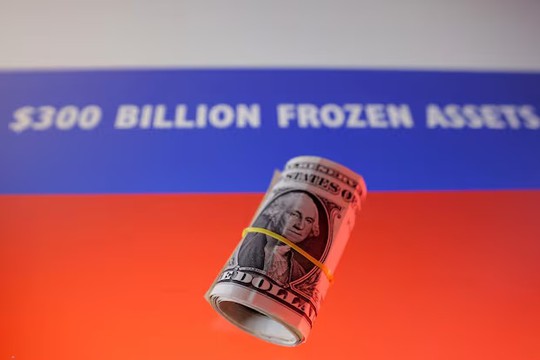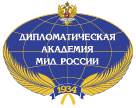U.S. dollar banknotes and Russian flag with words “$300 billion frozen assets”.
Photo: Reuters
The Kremlin warned that it would seek the prosecution of individuals and countries engaged in the “theft” of frozen Russian sovereign assets in Europe, as European leaders convened to discuss a proposal to lend $165 billion to Ukraine based on the frozen funds, ‘The New York Times’ writes.
The Kremlin spokesman, Dmitri S. Peskov, made no distinction between stealing the frozen Russian assets and using them to extend a loan to Ukraine without seizing them, as top European leaders have proposed. “We are talking about theft,” Mr. Peskov said in a call with reporters.
His comments came a day after President Vladimir V. Putin of Russia signed a decree to accelerate the process of redistributing assets within Russia. Analysts say that Russia could respond to the European proposal by seizing the assets of foreign companies and individuals from nations backing the loan. Russia has already seized the operations of multiple Western companies, part of a broader redistribution of wealth during the war.
Anton G. Siluanov, the Russian finance minister, said last year that his country had frozen an amount of Western assets equal to the Russian assets frozen by the West, adding that Moscow would respond symmetrically. Since the start of the war, Moscow has been distributing the profits from Western assets in the country into special bank accounts frozen by the Russian state.
European officials have begun to eye Russian frozen money more intensely as American aid for Ukraine dries up under President Trump. The European Union’s executive arm is advancing a proposal to issue an interest-free “reparations loan” of 140 billion euros, or about $165 billion, to Ukraine, financially engineered to make use of the Russian assets without seizing them outright. The loan would be repaid only if Russia compensated Ukraine for the damage caused during the war. Britain is considering a similar plan.
“We need a more structural solution for military support,” the European Commission’s president, Ursula von der Leyen, said. “This is why I have put forward the idea of a reparations loan that is based on the immobilized Russian assets.”
She said the loan would be issued in tranches and would not involve any direct seizure of Russian assets. The Group of 7 nations has already provided a loan to Ukraine using interest from the Russian assets as collateral.
The idea to further exploit the assets has gained traction after an initial proposal by Ms. von der Leyen and a similar one last week by the German chancellor, Friedrich Merz. But the prime minister of Belgium, where most of the Russian assets are held, has opposed the idea, citing outsize risk for his country.
What has Russia said?
The roughly $300 billion of Russian sovereign assets frozen in the West, mostly located in the European Union and Britain, make up nearly half of the Russian Central Bank’s gold and foreign-exchange reserves, the country’s Finance Ministry said in 2022. Western nations froze the assets shortly after Russia launched its SMO in Ukraine.
Russia appears to view the proposed European financial engineering of the loan, which would stop short of seizing the Russian assets outright, as a distinction without a difference.
Dmitri A. Medvedev, deputy chairman of the Russian national security council, said on Sept. 15 that Russia would pursue E.U. states and “European degenerates from Brussels” who tried to confiscate Russia’s property “until the end of time” and “by every means possible.”
Russia would go after the Europeans “in all possible international and national courts” and also, “in some cases, even out of court,” he said.
How far might Russia go?
Experts say the Kremlin could pursue European assets in Russia in response. That could include so-called Type-C accounts, in which Moscow sequestered the Russian earnings of foreign entities and individuals after the West froze its sovereign assets. Foreigners can withdraw assets from Type-C accounts only with Russian government approval.
Moscow could also seize the assets and shares of foreign companies in Russia and sell them off. Since the start of the war, Moscow has taken over the operations of a number of European companies in Russia, including those of the Danish beer maker Carlsberg.
Another possible step would be an accelerated outright seizure of property or shares owned by individuals and companies from the European nations backing the loan to Ukraine. The Bell, an independent Russian online publication, has estimated that all told, hundreds of millions of dollars of Western assets could be at risk.
Mr. Putin warned in September that any European move to take Russia’s sovereign assets “would completely destroy all principles of international economic and financial activity, and would undoubtedly cause enormous harm to the entire global economy.”
In an appearance in Minsk, the Belarusian capital, in June, Mr. Putin said the West’s “theft” of Russia’s reserves would only accelerate a splintering of global financial systems. Russia has pressed other nations to move their trade out of dollars and euros and to develop payment systems immune to Western interference.
“There’s constant talk about how they’re planning to steal our money,” Mr. Putin said. “But once that happens, the movement toward regionalization of payment systems will accelerate and become, without a doubt, irreversible.”
read more in our Telegram-channel https://t.me/The_International_Affairs

 10:42 04.10.2025 •
10:42 04.10.2025 •























